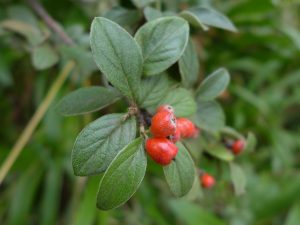In a paper recently published online, Debra Wotton (Moa’s Ark Research) and co-author Kate McAlpine (Department of Conservation) found that nearly a third of invasive plant species in New Zealand have fleshy-fruits whose seeds are dispersed by animals.

Non-native invasive plants (weeds) are one of the greatest threats to native biodiversity. New Zealand has well over 2,000 non-native plant species, of which around 14% are invasive. Animals can spread weeds to new locations by eating fleshy fruits (e.g. berries) and defecating or regurgitating seeds away from the parent plant.
In a paper published in New Zealand Journal of Ecology, we reviewed dispersal of fleshy-fruited weed seeds in New Zealand. Of the 295 weeds included in our review, almost a third (97 species) have fleshy fruits adapted for animal dispersal. So far, animals have been reported eating fruits or dispersing seeds of only 53 (55%) of these species. This may be because there have been few studies on weed seed dispersal in New Zealand. We also found that many of the weeds in New Zealand fruit from late autumn to early spring (May to September), when fruits of native plants are scarce.
Blackbirds, silvereyes and starlings are probably the most important weed dispersers in New Zealand – they are the most widespread species, and each disperse more than 20 weed species. Starlings can disperse seeds long distances, including to offshore island reserves where they roost overnight. Kereru (New Zealand pigeon), song thrushes, mynas, tui, bellbirds, possums and pigs also disperse weeds, although possums and pigs destroy some seeds. Kereru disperse three weed species with single-seeded fruits too large for other animals to swallow. Most seeds will be dispersed less than 100 m by birds, although some may be dispersed hundreds of metres or even several kilometres by birds and mammals.
Managing animal dispersal of weed seeds is challenging. Potential approaches include controlling possums and pigs, reducing weed seed availability using traditional or biological control, providing alternative food sources by planting natives that fruit during peak weed fruiting times and targeting favoured roost sites for surveillance and control.
A copy of the paper is available here.